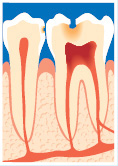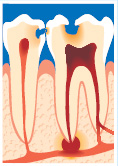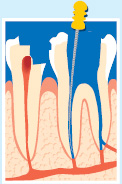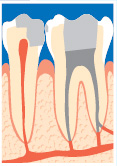The majority of root canal treatments are necessary when the tooth's nerve is damaged, either due to inflammation in the nerve or if the nerve is exposed after a trauma to the tooth causing it to crack. In some cases, a tooth may require root canal treatment for other reasons, such as when a crown is needed and there is very little tooth structure left.
You may not necessarily feel anything from a tooth that needs root canal treatment. Often it is first detected in connection with an x-ray at the dentist. The tooth may, however, be tender when chewing, give a throbbing or pulsating sensation. But the symptoms can also be sharp pains when consuming cold or hot food or drinks, swelling, or outright toothaches. If a tooth nerve has been dead for a long time, the tooth's color can also change to a darker shade.
An untreated infection in a tooth can spread to the bone around the tooth and ultimately spread to the bloodstream. It is a potentially life-threatening condition. Fortunately, this is a very rare complication, but it still means that we always recommend treating a tooth root infection. Even if there are no symptoms from the tooth or area.

Inflammation of the nerve in a tooth

Inflammation in the bone around the tooth
A root canal treatment is typically done in two sessions, with a week in between. During the first session, a hole is drilled through the tooth to access the root canal. The infected nerve and bacteria can then be removed. This part of the treatment is completed with a medication in the root canal that disinfects the canal. This is done to remove any remaining bacteria. A temporary filling is placed over the hole in the tooth. After the first round of root canal treatment, there may be some soreness in the tooth. Sometimes, the treatment can be completed during this first session.
Otherwise, the treatment continues with the second and final session. The root canal is filled with a rubber material that fills the empty space. This prevents new bacteria from entering the tooth. Once the root canal treatment is finished, the tooth is sealed with a plastic filling. This filling may sometimes be the final restoration for the tooth. However, it is often recommended that the tooth receives a crown afterwards. This is done to ensure that the weakened tooth does not crack and need to be removed.

First part of root canal treatment - removal of nerve and inflammation in the tooth

Completed root-treated tooth with temporary plastic filling.
There are many stories about root canal treatments being very painful. This is a myth! Root canal treatments at Tandlægerne Classensgade are always 100% painless.
For a successful outcome of a root canal treatment, it is important that the treatment is performed without new bacteria from the oral cavity entering the tooth. Therefore, all root canal treatments are carried out with the tooth shielded by a rubber dam. Sterile instruments are used, and the root canal is cleaned with sterile disposable files. At the same time, we use an electronic technique to determine the length of the tooth root, which is a more precise technique than just taking X-rays of the tooth.
* Illustrations borrowed from tandlaegeforeningen.dk